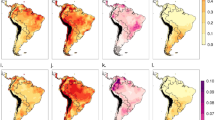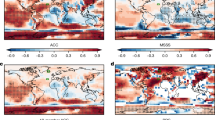Abstract
In this analysis, an update in the estimate of predictable component in the wintertime seasonal variability of atmosphere documented by Kumar et al. (J Clim 20: 3888–3901, 2007) is provided. The updated estimate of seasonal predictability of 200-hPa height (Z200) was based on North American Multi-Model Ensemble (NMME) forecast system. The seasonal prediction systems participating in the NMME have gone through an evolution over a 10-year period compared to models that were used in the analysis by Kumar et al. (J Clim 20: 3888–3901, 2007). The general features in the estimates of predictable signal conform with previous results—estimates of predictability remain high in the tropical latitudes and decrease towards the extratropical latitudes; and predictability in the initialized coupled seasonal forecast systems is still primarily associated with ENSO variability. As the horizontal and vertical resolution of the models used in the current analysis is generally higher, it did not have a marked influence on the estimate of the relative amplitude of predictable component. Although the analysis indicates an increase in the estimate of predictable component, however, it maybe related to the increase in ENSO related SST variance over 1982–2000 relative to 1950–2000 (over which the analysis of Kumar et al. in J Clim 20: 3888–3901, 2007 was). The focus of the analysis is wintertime variability in Z200 and its comparison with results in Kumar et al. (J Clim 20: 3888–3901, 2007), some analyses for summertime variability in Z200, and further, for sea surface temperature, 2-m temperature and precipitation are also presented.












Similar content being viewed by others
References
Barnett TP (1995) Monte Carlo climate forecasting. J Clim 8:1005–1022
Barnston AG, Kumar A, Goddard L, Hoerling MP (2005) Improving seasonal predictions practices through attribution of climate variability. Bull Am Meteorol Soc 85:59–72
Barnston AG, Tippett MK, L’Heureux ML, Li S, DeWitt DG (2012) Skill of real-time seasonal ENSO model predictions during 2002–2011—is our capability increasing? Bull Am Meteorol Soc 93(5):631–651
Becker E, van Dool Huug, Zhang Q (2014) Predictability and forecast skill in NMME. J Clim 27:5891–5906. doi:10.1175/JCLI-D13-00597.1
Chen M, Kumar A, Wang W (2015) A Study of the predictability of sea surface temperature over the tropics. Clim Dyn 44:1767–1776
Chervin RM (1986) Interannual variability and seasonal climate variability. J Atmos Sci 43:233–251
Delsole T, Kumar A, Jha B (2013) Potential seasonal predictability: comparison between empirical and dynamical model estimates. Geophys Res Lett 40:1–7
Guan Y, Zhu J, Huang B, Hu Z-Z, Kinter JL III (2014) South Pacific Ocean dipole: a predictable mode on multi-seasonal time scales. J Clim 27:1648–1658
Hoerling MP, Kumar A (2002) Atmospheric response patterns associated with tropical forcing. J Clim 8:474–495
Hoerling MP, Kumar A, Zhong M (1997) El Nino, La Nina, and the nonlinearity of their teleconnections. J Clim 10:1769–1786
Horel JD, Wallace JM (1981) Planetary-scale atmospheric phenomenon associated with the Southern Oscillation. Mon Weather Rev 109:2080–2092
Jha B, Kumar A (2009) A comparative analysis of change in the first and second moment of the PDF of seasonal means with ENSO SSTs. J Clim 22:1412–1423
Kalnay E, Kanamitsu M, Kistler R, Collins W, Deaven D, Gandin L, Iredell M, Saha S, White G, Woollen J, Zhu Y, Chelliah M, Ebisuzaki W, Higgins W, Janowiak J, Mo KC, Ropelewski C, Wang J, Leetmaa A, Reynolds R, Jenne R, Joseph D (1996) The NCEP/NCAR 40-year reanalysis project. Bull Am Meteorol Soc 77:437–471
Kirtman BP et al (2014) The North American multimodel ensemble: phase 1 seasonal-to-interannual prediction; phase-2 toward developing intraseasoanl prediction. Bull Am Meteorol Soc 95:585–601
Kumar A (2009) Finite samples and uncertainty estimates for skill measures for seasonal predictions. Mon Weather Rev 137:385–392
Kumar A, Hoerling MP (1995) Prospects and limitation of seasonal atmospheric GCM predictions. Bull Am Meteorol Soc 76:335–345
Kumar A, Hoerling MP (2000) Analysis of a conceptual model of seasonal climate variability and implications for seasonal prediction. Bull Am Meteorol Soc 81:255–264
Kumar A, Hu Z-Z (2014) How variable is the uncertainty in ENSO sea surface prediction? J Clim 27(7):2779–2788. doi:10.1175/JCLI-D-13-00576.1
Kumar A, Murtugudde R (2013) Predictability and uncertainty: a unified perspective to build a bridge from weather to climate. COSUST 5:327–333
Kumar A, Barnston AG, Hoerling MP (2001) Seasonal prediction, probabilistic verifications, and ensemble size. J Clim 14:1671–1676
Kumar A, Schubert SD, Suarez MS (2003) Variability and predictability of 200-mb seasonal mean heights during summer and winter. J Geophys Res 108:4169. doi:10.1029/2002JD002728
Kumar A, Jha B, Zhang Q, Bounoua L (2007) A new methodology for estimating the uppredictable component of seasonal atmospheric variability. J Clim 20:3888–3901
Kumar A, Perlwitz J, Eischeid J, Quan X, Xue T, Zhang T, Hoerling M, Jha B, Wang W (2010) Contribution of sea ice loss to Artic amplification. Geophys Res Lett 37:1–6
Kumar A, Chen M, Wang W (2011) An analysis of prediction skill of monthly mean climate variability. Clim Dyn 37:1119–1131
Kumar A, Hu Z-Z, Jha B, Peng P (2016) Estimating ENSO predictability: based on multi-model hindcasts. Clim Dyn. doi:10.1007/s00382-016-3060-4
Madden RA (1976) Estimates of the natural variability of time-averaged sea-level pressure. Mon Weather Rev 104:942–952
National Research Council (2010) Assessment of intraseasonal to interannual climate prediction and predictability. the National Academies Press, Washington, 192 pp., ISBN-10: 0-309-15183-X
Peng P, Kumar A, Barnston AG, Goddard L (2000) Simulation skills of the SST-forced global climate variability of the NCEP-MRF9 and Scripps-MPI ECHAM3 models. J Clim 13:3657–3679
Quan X, Hoerling M, Whitaker J, Bates G, Xu T (2006) Diagnosing sources of US seasonal forecast skill. J Clim 19:3279–3293. doi:10.1175/JCLI3789.1
Reynolds RW, Rayner NA, Smith TM, Stokes DC, Wang W (2002) An improved in situ and satellite SST analysis for climate. J Clim 15:1609–1625
Rowell DP (1998) Assessing potential predictability with an ensemble of multi-decadal GCM simulations. J Clim 11:109–120
Sardeshmukh PD, Compo GL, Penland C (2000) Changes of probability associated with El Niño. J Clim 13:4268–4286
Screen JA, Deser C, Simmonds I, Tomas R (2014) Atmospheric impacts of Arctic sea-ice loss, 1979–2009: separating forced change from atmospheric internal variability. Clim Dyn 43:333–344
Shukla J et al (2000) Dynamical seasonal prediction. Bull Am Meteorol Soc 81:2593–2606
Stern W, Miyakoda K (1995) Feasibility of seasonal forecasts inferred from multiple GCM simulations. J Clim 8:1071–1085
Straus D, Shukla J, Paolino D, Schubert S, Suarez M, Pegion P, Kumar A (2003) Predictability of the seasonal mean atmospheric circulation during autumn, winter, and spring. J Clim 16:3629–3649
Treenberth KE, Branstator GW, Karoly D, Kumar A, Lau N-C, Ropelewski C (1998) Progress during TOGA in understanding and modeling global teleconnections associated with tropical sea surface temperature. J Geophys Res 103(7):14291–14324
Zwiers FW, Wang XL, Sheng J (2000) Effects of specifying bottom boundary conditions in an ensemble of atmospheric GGCM simulations. J Geophys Res 105:7295–7316
Acknowledgments
The NMME project and data dissemination are supported by NOAA, NSF, NASA and DOE. The help of NCEP, IRI and NCAR personnel in creating, updating and maintaining the NMME archive is acknowledged. All the data used in this paper are available at NOAA Climate Prediction Center (CPC) (http://www.cpc.ncep.noaa.gov/products/NMME/). The scientific results and conclusions, as well as any view or opinions expressed herein, are those of the authors and do not necessarily reflect the views of NWS, NOAA, or the Department of Commerce.
Author information
Authors and Affiliations
Corresponding author
Additional information
This paper is a contribution to the special collection on the North American Multi-Model Ensemble (NMME) seasonal prediction experiment. The special collection focuses on documenting the use of the NMME system database for research ranging from predictability studies, to multi-model prediction evaluation and diagnostics, to emerging applications of climate predictability for subseasonal to seasonal predictions. This special issue is coordinated by Annarita Mariotti (NOAA), Heather Archambault (NOAA), Jin Huang (NOAA), Ben Kirtman (University of Miami) and Gabriele Villarini (University of Iowa).
Rights and permissions
About this article
Cite this article
Jha, B., Kumar, A. & Hu, ZZ. An update on the estimate of predictability of seasonal mean atmospheric variability using North American Multi-Model Ensemble. Clim Dyn 53, 7397–7409 (2019). https://doi.org/10.1007/s00382-016-3217-1
Received:
Accepted:
Published:
Issue Date:
DOI: https://doi.org/10.1007/s00382-016-3217-1




